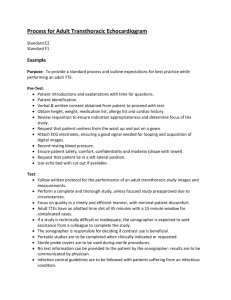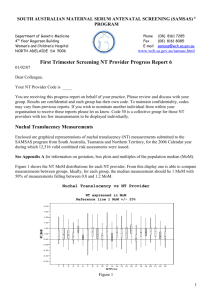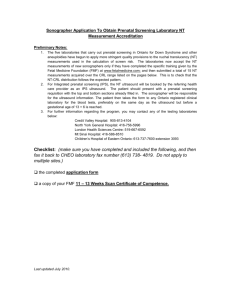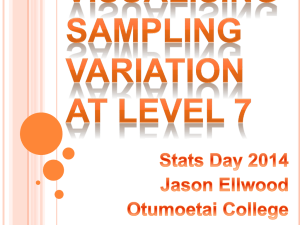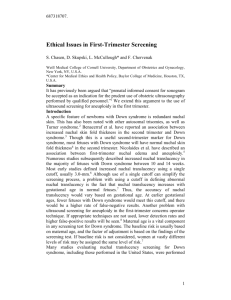Wolfson Institute 2013 - Medical Screening Society
advertisement
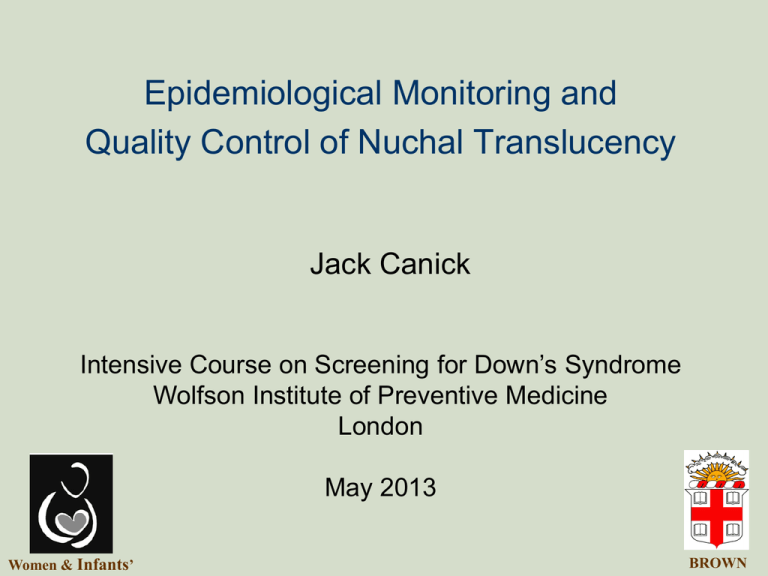
Epidemiological Monitoring and Quality Control of Nuchal Translucency Jack Canick Intensive Course on Screening for Down’s Syndrome Wolfson Institute of Preventive Medicine London May 2013 Women & Infants’ BROWN NT Training Programs Fetal Medicine Foundation Less formalized systems Overview Epidemiological monitoring is the study of the measurements made on the population being tested Application of serum marker experience to nuchal translucency monitoring Examples of monitoring activities for nuchal translucency New sonographer data The Level of Maternal Serum AFP Increases with Increasing Gestation log-linear increase slope = +15% per week Palomaki GE, unpublished data Nuchal Translucency Thickness Increases with Increasing Gestation log-linear increase slope = +20% per week Schuchter et al, Prenat Diagn 1998; 18: 281-4 AFP SD of log MoM = 0.15 MS AFP (MoM) The Distribution of AFP and NT MoM in Unaffected Pregnancies NT SD of log MoM = 0.10 NT (MoM) Why is NT such a good marker? unaffected NT: 0.11 SD DS 0.2 0.5 1 2 NT (MoM) 0.5 5 10 DS unaffected 0.2 50% DR 1% FPR 1 2 hCG (MoM) 5 hCG: 0.24 SD 10 50% DR 8% FPR Nuchal Translucency (NT) Epidemiological monitoring NT parameters that are monitored: Rate of increase with CRL log-linear over 10,3 - 13,6 weeks should go up by ~ 20% per week Median calculated MoM values should be stable at 1.0 MoM SD of the distribution calculated SD of the log MoM values expected to be about 0.1 NT medians by CRL: All Centers NT change with gestation NT medians by CRL: All Centers median MoM Distribution width Epidemiologic Monitoring of Nuchal Translucency: Monthly Medians - A Epidemiologic Monitoring of Nuchal Translucency: Monthly Medians - B NT data monitoring Use objective criteria as guide Partially subjective process Look for trends Sample volume must be considered What to do with very small volume sonographers? Sonographer feedback has been minimally useful Getting started: Newly trained sonographers Provide paired CRL and NT measurements to the laboratory If more than one sonographer within a center, identify each person within the database Expect data to conform to parameters defined in literature New sonographer A NT (mm) Reference (slope +20% per week) New sonographer A +14% 1 30 40 50 60 CRL (mm) 70 80 Sonographer variation: New sonographer B NT (mm) Reference (slope +20% per week) New sonographer B +48% 1 30 40 50 60 CRL (mm) 70 80 Sonographer challenges: New sonographer C NT (mm) 3 Reference Reference(slope (slope+20% +20%per perweek) week) New Newsonographer sonographerBC ? 1 30 40 50 60 CRL (mm) 70 80 Published Literature: Variation in NT median measurement FMF-certified centers Non-FMF certified Schielen PC et al., Prenat Diagn 2006;26:711-8 Published Literature: Variation in NT median measurement Range of NT measurements (in MoM) between hospitals Inter-operator variation at one hospital Crossley JA et al. BJOG 2002;109:667-76. NT Epidemiologic Monitoring NT Medians (mm) at 15 FASTER Centers 3.0 2.7 2.4 2.1 1.8 NT (mm) 1.5 1.2 0.9 0.6 0.3 10 11 12 G.A. (week) 13 14 NT Epidemiologic Monitoring Impact of Using A Single Population Median NT (mm) Example of a 30 year old who has the most typical result at 12 wks 3.0 2.7 2.4 2.1 1.8 1.5 Center A is routinely high: result 1.3mm = = 1.67 MoM median 0.8mm risk: 1 in 230 1.2 Center B is routinely average: 0.9 result 0.8mm = median 0.8mm 0.6 = 1.00 MoM risk: 1 in 2400 Center C is routinely low: 0.3 10 11 12 13 G.A. (week) 14 result = 0.6mm = 0.75 MoM median 0.8mm risk: 1 in 3500 Patient-specific risk varies 15 fold. NT Epidemiologic Monitoring Impact of Using Center-Specific Medians NT (mm) Example of a 30 year old who has the most typical result at 12 wks 3.0 2.7 2.4 2.1 1.8 1.5 Center A is routinely high: result 1.3mm = = 1.00 MoM median 1.3mm risk: 1 in 2400 1.2 Center B is routinely average: result 0.8mm = = 1.00 MoM median 0.8mm risk: 1 in 2400 0.9 0.6 0.3 10 11 12 13 G.A. (week) Center C is routinely low: result = 0.6mm = 1.00 MoM 14 median 0.6mm risk: 1 in 2400 Patient-specific risk is the same at each center. Palomaki GE et al. Genet Med 2008;10(2):131-138

